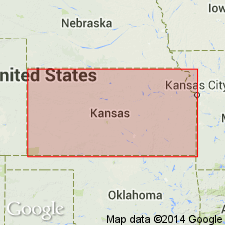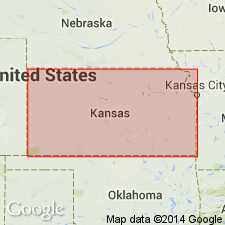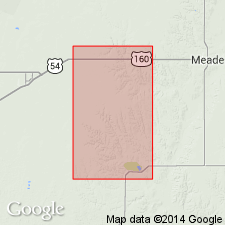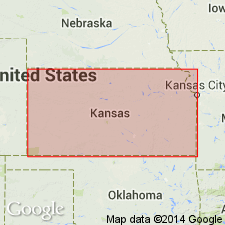
- Usage in publication:
-
- Atchison formation
- Modifications:
-
- Original reference
- Dominant lithology:
-
- Sand
- Silt
- AAPG geologic province:
-
- Forest City basin
Summary:
Pg. 12 (fig. 5), 15. Atchison formation. Consists of well-sorted sand and silt with sand and gravel at base; commonly thinly laminated in upper part. In Atchison County, Kansas, has a maximum thickness of 80 feet; commonly 40 feet thick. Not recognized beyond the limits of Kansan glaciation. Overlies Nebraska till; underlies Kansas glacial till. Comprises pro-Kansas outwash of early Kansas age. Age is Pleistocene. Report includes columnar section.
Named from exposures in the vicinity of Atchison, Atchison Co., northeastern KS.
Source: US geologic names lexicon (USGS Bull. 1200, p. 160); supplemental information from GNU records (USGS DDS-6; Denver GNULEX).

- Usage in publication:
-
- Atchison formation
- Modifications:
-
- Principal reference
- AAPG geologic province:
-
- Forest City basin
Summary:
Pg. 51, 62 (fig. 2), 70-74, pl. 1. Extended into Nebraska where it overlies Red Cloud formation. Type locality designated. [Age is Pleistocene.]
Type locality: exposures in creek bank in SE/4 SW/4 sec. 2, T. 6 S., R. 20 E., Atchison Co., northeastern KS.
Source: US geologic names lexicon (USGS Bull. 1200, p. 160).

- Usage in publication:
-
- Atchison member
- Modifications:
-
- Revised
- AAPG geologic province:
-
- Anadarko basin
Summary:
Pg. 55 (fig. 1). In revised classification, Atchison is basal member of unnamed formation in upper part of Meade group. [Age is Pleistocene.]
Source: US geologic names lexicon (USGS Bull. 1200, p. 160).

- Usage in publication:
-
- Atchison Formation
- Modifications:
-
- Overview
- AAPG geologic province:
-
- Forest City basin
Summary:
(Cenozoic Era; Quaternary System by C.K. Bayne and H.G. O'Connor, p. 60 (table 3), 63.) The Atchison Formation is a proglacial deposit which is not recognizable beyond the limits of Kansan glaciation. It is composed of fine-grained sand and silt and locally gravel at the base. The upper part is thinly laminated. Similar deposits occur between the Cedar Bluffs and Nickerson tills. The maximum known thickness is nearly 100 feet, but it is commonly less than 40 feet thick. Occurs above Afton soil and below Nickerson till (p. 60, tbl. 3). Age is Pleistocene (Kansan).
Source: Publication.
For more information, please contact Nancy Stamm, Geologic Names Committee Secretary.
Asterisk (*) indicates published by U.S. Geological Survey authors.
"No current usage" (†) implies that a name has been abandoned or has fallen into disuse. Former usage and, if known, replacement name given in parentheses ( ).
Slash (/) indicates name conflicts with nomenclatural guidelines (CSN, 1933; ACSN, 1961, 1970; NACSN, 1983, 2005, 2021). May be explained within brackets ([ ]).

